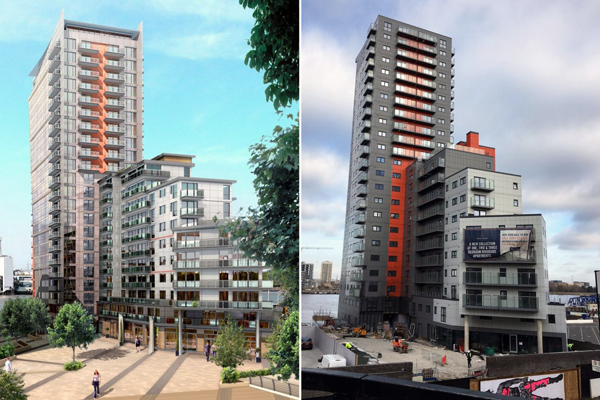A legal battle is brewing in the U.K. concerning a residential rental apartment development that allegedly strayed from its approved design. The Royal Borough of Greenwich has issued an enforcement notice demanding the complete demolition of two towers in the complex due to the number of serious design deviations. The tallest tower is 23 storeys high. More than 200 apartments are affected overall.
“The council’s extensive investigation over the last year has concluded that the completed Mast Quay Phases II built-to-rent-development has been built without planning permission and is therefore unlawful because it is so substantially different to the scheme that was originally permitted by the planning permission given in 2012,” the council said in a detailed statement in late September. “In total, there are at least 26 main deviations to the original planning permission.”
Deviations include changes to windows, cladding and balconies. The developer also increased the building footprints, eliminated amenities such as rooftop gardens, children’s play areas, landscaped gardens, and reduced the commercial floor space and underground parking. Overall, the buildings were judged to provide “lower quality residential accommodation” than what was first approved.

The Mast Quay development had undergone an ownership change since the project’s inception that may have contributed to alterations being made along the way.
According to the borough, the Mast Quay project received planning approval in 2012 after the concept was first filed in 2010. However, the original developer went into “administration,” a U.K. business insolvency process, sometime after Phase I was completed. Developer Comer Homes bought into the project to complete Phase II, which is the subject of the council’s enforcement order.
“The right thing to do is not usually the easy thing to do,” said Coun. Anthony Okereke, leader of the Royal Borough of Greenwich. Mast Quay Phase II represents two prominent highrise buildings on Woolwich’s riverside that just are not good enough, and the reason that they are not good enough is because the development that was given planning permission is not the one that we can all see before us today.”
Comer Homes is not pleased with the local council’s decision and intends to appeal.
“The Comer Homes Group is surprised and extremely disappointed by the decision of the Royal Borough of Greenwich to issue an enforcement notice in respect of our Mast Quay Phase II development,” a company spokesperson said. “Comer Homes Group remains steadfast that the council’s position is inaccurate and misrepresents the situation.”
If the order is acted upon, a large number of tenant families will be dislodged and be forced to find alternate accommodation. They will be allowed to stay in their apartments until any appeal by Comer Homes is lost.
A decision of this magnitude is highly unusual. Could this happen here in Canada?
“Unfortunately, this type of situation appears to be fairly common — where construction proceeds, but does not comply with applicable law or the requirements of authorities having jurisdiction,” Edward Lynde, partner at Fasken Martineau DuMoulin LLP told the Daily Commercial News. “Construction may be impacted, including the potential for demolition.”
Referencing the U.K. situation, Lynde said it was not clear whether periodic reviews by the relevant municipal authorities took place to determine if the construction was progressing as per the approved design.
“There needs to be oversight for such construction projects to ensure compliance with applicable laws, which is especially important to ensure health and safety are maintained at all stages, including with the finished work, structure or project generally.”
There are risks for both the project developer and the municipality.
“Failure to undertake, execute, and discharge its duties with respect to construction oversight and compliance can attract liability for that municipality,” said Lynde. “Obviously, this (demolition) is not a desired outcome, particularly for the affected owners, either residential or commercial. However, given the obligations imposed upon a municipality, decisions are typically made by municipalities to ensure that construction conforms to building plans and health and safety standards are met.”
John Bleasby is a Coldwater, Ont.-based freelance writer. Send comments and Legal Notes column ideas to editor@dailycommercialnews.com.







Recent Comments
comments for this post are closed